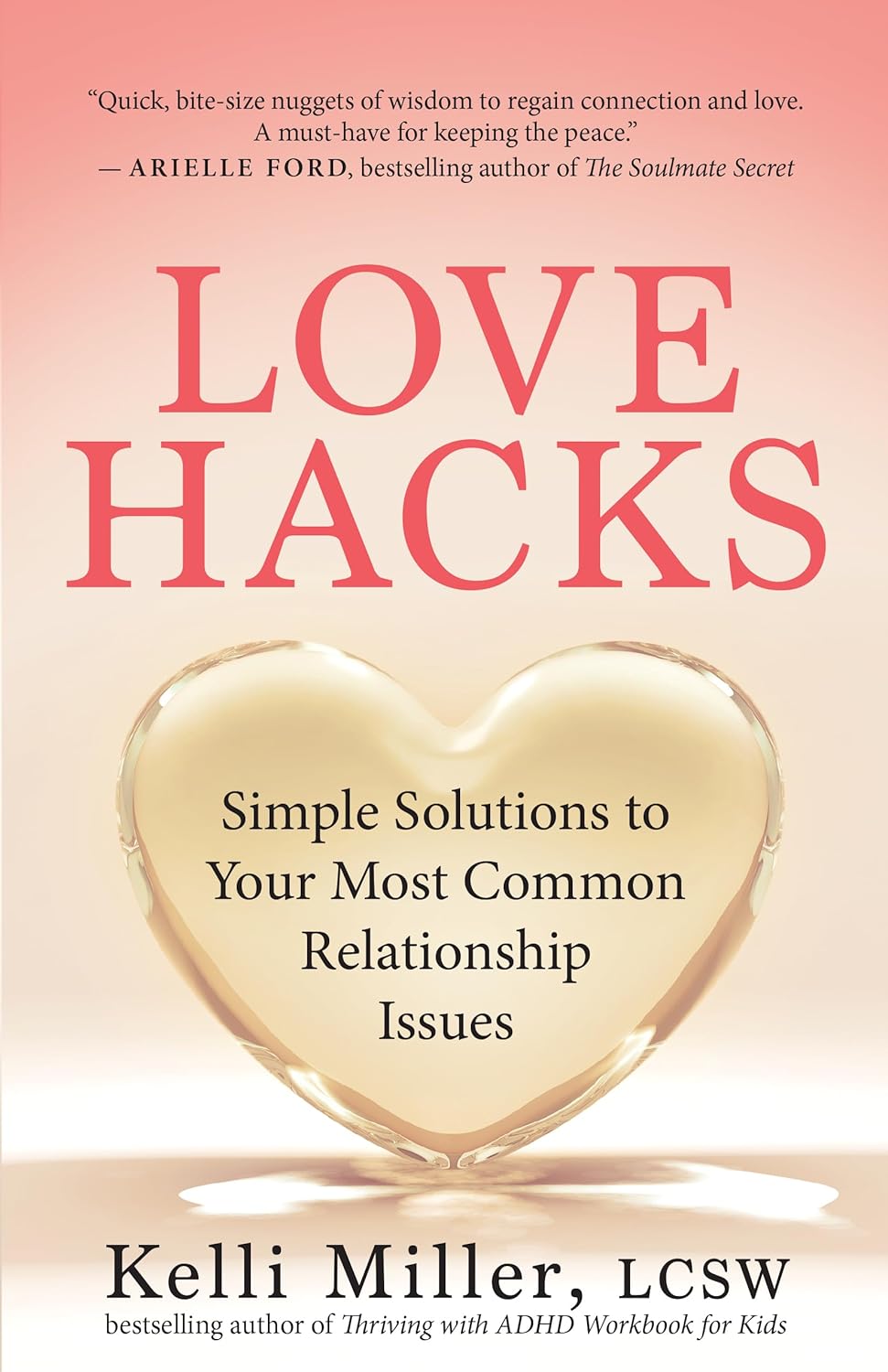
An Excerpt from Love Hacks by Kelli Miller , LCSW, MSW

“You never listen to me!”
“Hello, are you even hearing me?”
“I feel like the only time I’m heard is if I scream!”
One of the most satisfying parts of a relationship is feeling heard. It’s sharing something vulnerable and feeling “seen,” or completely understood, by our partner. Feeling seen is the ultimate indication of being valued, acknowledged, and appreciated. This means feeling like our partner understands what we’ve said and gets our wants, needs, and vulnerabilities.
Everyone wants to feel seen and heard. This is true across the board; we all want to feel appreciated and special. We all want to feel we matter. This is especially true in our relationships. Not only does listening well to our partner make them feel seen, but listening well prevents arguments. To be a better listener enables a deeper connection with our partner and ultimately a better partnership.
Listening is one of those concepts that seems simple in theory but is often difficult in practice. Many of us today may not even realize listening is a skill. In fact, we may never have been taught the skill of active listening nor even understand what true listening really means. For example, did you know that there is a distinct difference between “hearing” and “listening”?
Hearing is effortless, involuntary, and passive. We hear music and a dog barking down the street. We don’t do anything to hear; sounds just reach our ears. Conversely, listening is focused and intentional; we are seeking information and understanding. We listen to our boss so we know what task they want us to do. We listen to directions. Listening is about processing communication, in part so we know what others want and what we should do, and this takes work and awareness.
If our partner ever says to us, “You’re not listening to me,” they aren’t concerned that we haven’t heard their words. Rather, they don’t feel we are understanding their meaning, intentions, perspective, or emotions. They don’t feel recognized or “seen.” To put it another way, through active listening, we make our partner feel valued by seeking to understand them. In order to have a better partnership, we need to learn how to listen to each other, not just hear each other.
This chapter presents three listening tools: fast-food communication, “I” statements, and sounding board vs. feedback. Practicing these techniques with your partner will improve the quality of your listening and help your partner feel more connected and understood. These tools are essential for stronger communication and connection.
Fast-Food Communication Conversations, requests, questions, and even comments from partners can easily get misheard and misinterpreted. It happens all the time, especially when partners are upset. This
simple tool is useful for clarifying what someone has said.
In the multibillion-dollar fast-food industry, employees are trained to repeat each order when it’s placed. For example, at McDonalds, if someone orders an Oreo McFlurry and a small fries, the employee will repeat back: “I have an Oreo McFlurry and a small fries.” The order is also shown on the screen. That gives the customer the opportunity to correct the employee if they didn’t hear the order correctly. This can happen easily for all sorts of reasons: It could be user error (the person didn’t speak loudly enough or was indecisive and confused the employee), an equipment malfunction (the speaker wasn’t working; the computer glitched), or general interference (kids screaming or someone else speaking). Accuracy is key, and repetition ensures clarity.
We can use this same technique with our partner and to serve the same purpose: to prevent miscommunication. Just like in fast-food restaurants, repeating what we hear gives our partner a chance to make sure we have heard them correctly. This technique also forces both partners to slow down, which helps keep emotions from taking over.
For instance, Milo and Talia, a couple in their thirties, came to me because they both felt they weren’t “listening to each other.” I asked for an example. Talia told me that just last night Milo had come home late from work, cooked, and then completely forgotten to clean up the dishes, which left a mess in the kitchen. Talia admitted that when she woke up in the morning and saw the mess, she “snapped” at Milo. Milo said he couldn’t understand why Talia was so angry. Talia shrugged and said, “See, he just doesn’t get it!”
I suggested that they both experiment with fast-food communication. To practice, I asked Talia to first say how she was feeling.
Talia: “I felt upset that you came home late, then didn’t clean up the dishes.”
Then I asked Milo to repeat back what he heard.
Milo: “What I’m hearing you say is that you felt upset that I came home late, then didn’t clean up the dishes.”
The phrase “What I’m hearing you say is …” signals that Milo is confirming his understanding. This gives partners the opportunity to correct each other if they hear the statement wrong. It’s a small but mighty phrase. First, Milo needs to make sure he is hearing exactly what Talia is trying to communicate.
This effort to confirm understanding, while providing the opportunity for clarification, helps partners feel heard. Once Milo repeated back what Talia said, she immediately felt understood and validated and was able to soften. Validation was the missing piece of the puzzle; suddenly, she felt like a priority because Milo was making her one. Milo still didn’t understand why the dirty dishes made her so angry, but for Talia, it wasn’t really about the mess. She wanted her feelings confirmed.
Our instinct is often to defend or protect ourselves. But once we feel validated, we can let our guard down. We can then be more receptive to our partner’s experience or perspective.
Milo: “I’m so sorry I was late and didn’t clean up the dishes. I can understand how that can feel frustrating, especially when you see it first thing in the morning. My supervisor had me finish up one last spreadsheet, and I was exhausted by the time I got home.”
Milo took accountability and acknowledged Talia’s feelings, and then he explained why it happened. This helped Talia let go of her anger, and she used the fast-food technique with Milo:
Talia: “What I’m hearing you say is that your supervisor kept you at work late, so you were too tired to clean up after the meal you made, and you’re sorry about that. It was hard for me to see the mess in the morning, but I understand why it happened. I’m sorry I snapped at you. It was unnecessary.”
In general, partners feel less defensive once they feel heard, first and foremost. Talia was angry, but once Milo validated her — simply by repeating her words using fast-food communication — she felt more connected and seen.
To clarify, fast-food communication just involves repeating back what a partner has said to ensure clarity and validate the partner. It’s not about defending ourselves. The goal is to make our partner feel understood.
As Talia and Milo demonstrate, this is about more than merely repetition. Here is an initial template for this kind of conversation, which you can follow and adapt as needed:
Partner 1: I feel ___ [name feeling] about the ___ [circumstance].
Partner 2: What I’m hearing you say is that you feel ___ [name feeling] about the ___ [circumstance].
Partners then alternate “hearing” each other until both feel supported and understood. The conversation should end with apologies from both partners for their parts. Again, this is not a time to defend or prove your point; it’s more about trying to confirm your partner’s feelings.
It can sound a bit odd at first to just repeat back what a partner is saying, and people may even feel a bit like a parrot. But active listening begins with making sure we hear our partner correctly and that they feel validated. It’s as simple as starting with: “What I’m hearing you say is …”
Excerpted from the book Love Hacks. Copyright© 2024 by Kelli Miller, LCSW, MSW. Reprinted with permission from New World Library.www.newworldlibrary.com
We’d love to hear from you! Please send us your suggestions for future articles. And if you’re a writer, please see our writer’s submissions page for details.

